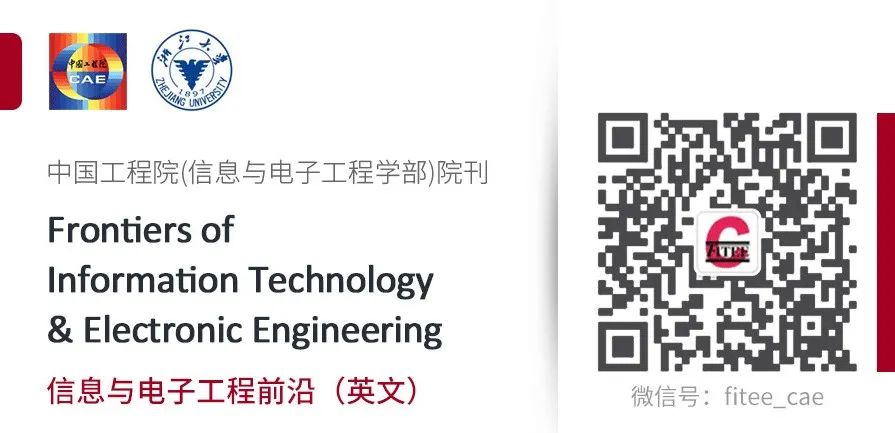

Satellite Internet is the third revolution in the Internet after fixed and mobile communication networks. Specifically, Satellite Internet is a wireless network that uses a satellite network as the access network. On one hand, Satellite Internet breaks through the coverage limitations of terrestrial Internet, achieving seamless global coverage. The land area accounts for only 29% of the global area, and even on land, terrestrial Internet only covers part of urban and rural areas. Vast remote areas such as oceans, deserts, forests, and mountains lack effective wireless coverage. However, the cost of building new terrestrial networks in these areas is extremely high and maintenance is very difficult, which urgently requires the use of satellite networks as access networks for Satellite Internet. With the decline in the costs of satellite manufacturing, launching, and communication, achieving global coverage using satellite networks has become possible, creating conditions for the construction of a satellite Internet of Things. Moreover, Satellite Internet breaks through the original human-centered network model, achieving true Internet of Everything. In recent years, with the development of the economy and society, a massive number of wireless devices need to connect to wireless networks. Satellite Internet has advantages such as large access capacity, strong damage resistance, and minimal weather impact, creating conditions for global interconnectivity.
According to the different altitudes of satellites, satellite networks are typically divided into low Earth orbit, medium Earth orbit, and high Earth orbit. Low Earth orbit satellite networks have low orbits, resulting in lower transmission delays and losses, and are usually used as access networks for Satellite Internet. For example, SpaceX’s Starlink Internet operates at an altitude of about 500 kilometers. However, low Earth orbit satellites move quickly, and the visibility time of a single satellite is very short. To achieve seamless global coverage, a large number of low Earth orbit satellites need to be deployed to form a network, i.e., a low Earth orbit satellite constellation. In recent years, significant work has been done in academia and industry on the networking theory and key technologies of Satellite Internet, achieving important breakthroughs, mainly including inter-satellite communication technology, satellite network protocols, resilient routing protocols, and mobility management. In particular, the introduction of direct satellite communication technology for mobile phones has further improved the networking methods of Satellite Internet, significantly enhancing its functionality. First, Satellite Internet frees itself from dependence on terrestrial devices, greatly enhancing mobility and truly achieving global mobile access. Second, existing mobile phones can also directly access Satellite Internet, achieving downward compatibility. Finally, the collaboration between Satellite Internet and terrestrial networks achieves the goal of an integrated space-ground network.
This frontier theme includes the number of core papers published from 2017 to 2022 (Note: High-impact papers in the top 10% of citations for this theme retrieved from Web of Science as of January 2023) and their annual publication situation as shown in tables 1.1.1 and 1.1.2.
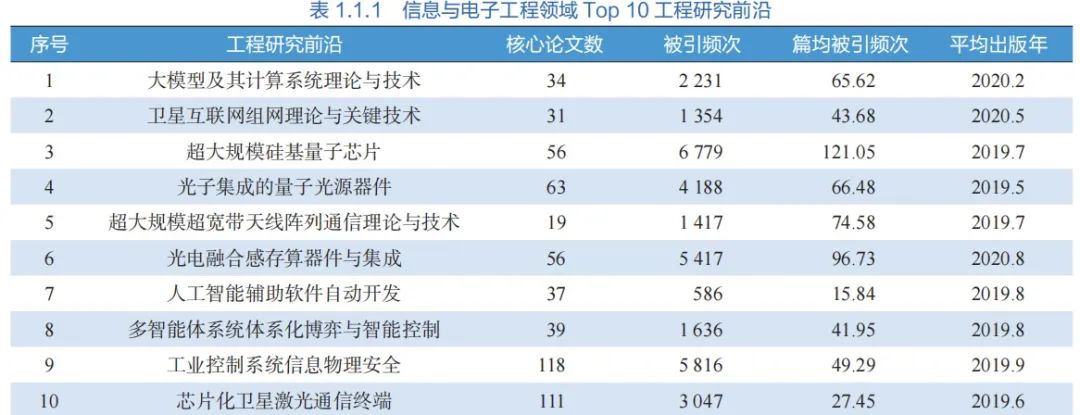
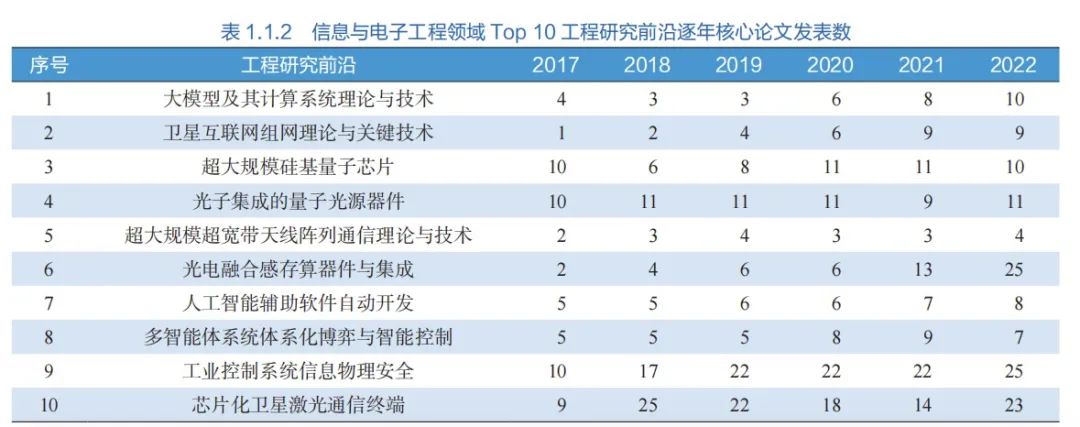
Satellite Internet represents a new transformation in the Internet field, characterized by “global coverage, on-demand access, service as needed, and secure and reliable” features, providing strong support for achieving the vision of global interconnectivity, thus attracting the attention of various countries. In the 1990s, Motorola established the Iridium system, consisting of 66 low Earth orbit satellites, featuring inter-satellite links and onboard processing capabilities. Meanwhile, companies like Loral and Qualcomm built the Globalstar system, which includes 48 low Earth orbit satellites, each employing transparent forwarding. Due to commercial reasons, both satellite Internet systems underwent bankruptcy reorganization. After a period of decline, Satellite Internet has recently entered a second wave of enthusiasm, with even larger scales. In 2017, OneWeb proposed a plan to launch 1,980 satellites to form a globally covering low Earth orbit constellation. SpaceX plans to launch 42,000 low Earth orbit satellites to create the Starlink system, supporting high-speed mobile communication globally. In recent years, China has also been accelerating the construction of Satellite Internet. For example, the “Hongyan Constellation” designed by China Aerospace Science and Technology Corporation consists of 324 satellites, while the “Hongyun Constellation” by China Aerospace Science and Industry Corporation includes 156 satellites.
Although Satellite Internet has experienced rapid development, there are still many challenging issues in network architecture, routing protocols, inter-satellite communication, and mobility management that need further breakthroughs.
1) In terms of network architecture, there are currently two mainstream network architectures. One is the non-terrestrial network (NTN) led by the International Mobile Telecommunications Standardization Organization (3GPP). This network architecture is compatible with terrestrial cellular networks and is an important component of the entire 6G network, enabling compatibility with existing terrestrial networks and exhibiting openness. The other is a network architecture designed specifically for Starlink by SpaceX, which is closed. The main research institutions in this direction include Harbin Institute of Technology, Chinese Academy of Sciences, Waseda University, Huawei, and others.
2) In terms of routing protocols, due to the highly dynamic nature of satellite networks, the positions of satellites are constantly changing, making terrestrial network routing protocols unsuitable, thus necessitating the design of new resilient routing protocols. The basic idea is to utilize the regularity of constellation movement to map real satellite nodes to virtual nodes. When satellites move or ground terminals switch, the routing tables between virtual nodes exchange information among physical nodes to complete routing information exchange. The main research institutions in this direction include University of Surrey, SpaceX, Beijing University of Posts and Telecommunications, Xi’an University of Electronic Science and Technology, National University of Defense Technology, and Beijing Institute of Technology.
3) In terms of inter-satellite communication, there are currently two development trends. One is inter-satellite microwave communication, which has been widely applied and is technologically mature. However, microwave communication has limitations in frequency band capacity, cannot meet high-speed communication requirements, and suffers from severe co-frequency interference. The second is inter-satellite laser communication, which is a commonly adopted method for the next generation of Satellite Internet. Compared to microwave communication, laser communication has advantages such as large bandwidth, small communication payload, strong anti-interference, and confidentiality. The main research institutions in this direction include University of Surrey, SpaceX, Chinese Academy of Sciences, Beijing University of Posts and Telecommunications, University of Electronic Science and Technology, and Zhejiang University.
4) In terms of mobility management, there are two approaches. One is centralized mobility management, which uses local agents to manage terminals, requiring terminals to transmit messages to local agents each time they initiate a location update. The other is distributed mobility management, which divides the globe into multiple zones, with each zone consisting of a satellite group covering that location as a virtual gateway. Terminals register with the gateway of their location zone, thus meeting the mobility management needs of large-scale satellite networks. The main research institutions in this direction include Pengcheng Laboratory, Southeast University, University of Luxembourg, Huawei, and ZTE.
The main output countries of the core papers in this frontier are shown in table 1.2.5. China has a significant advantage, ranking first in the number of core papers, accounting for over 67%, and collaborating with Japan, the UK, Saudi Arabia, South Korea, Canada, Australia, and Norway (figure 1.2.4). Among the top ten institutions producing core papers (table 1.2.6), the Chinese Academy of Sciences and Harbin Institute of Technology are tied for first place; seven of the institutions are from China, while the others are distributed in Saudi Arabia, Japan, and Luxembourg. In terms of institutional collaboration (figure 1.2.5), King Abdulaziz University, Waseda University, and Xi’an University of Posts and Telecommunications have close cooperation. In terms of citing core papers (table 1.2.7), China still ranks first, accounting for over 50%, while the proportions for other countries are all below 10%; among the top ten institutions producing citing core papers (table 1.2.8), except for Waseda University ranked sixth, the rest are all from China, reflecting China’s strong research capabilities in this direction.
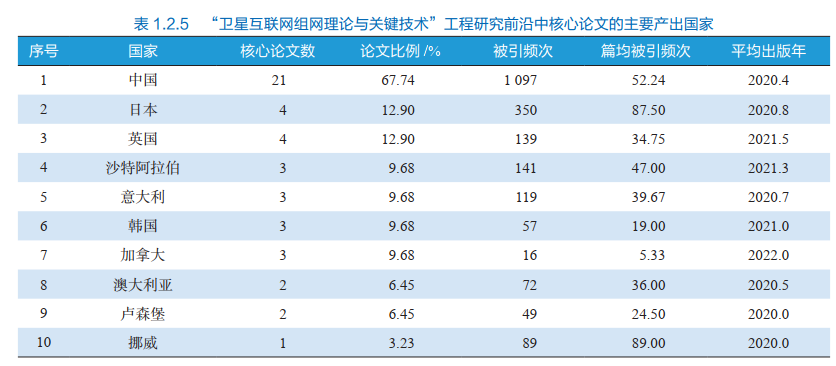

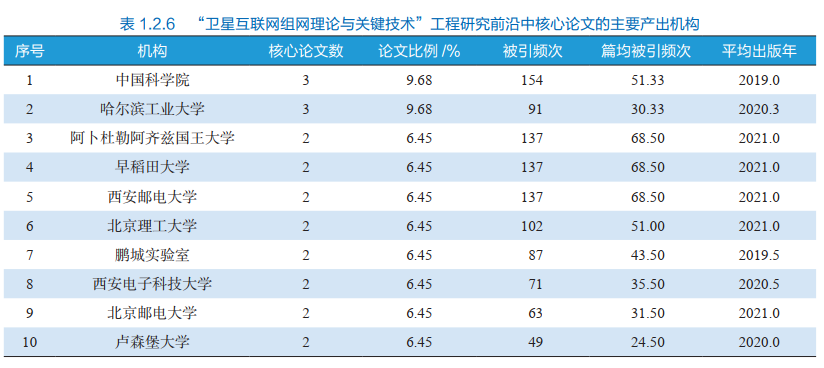
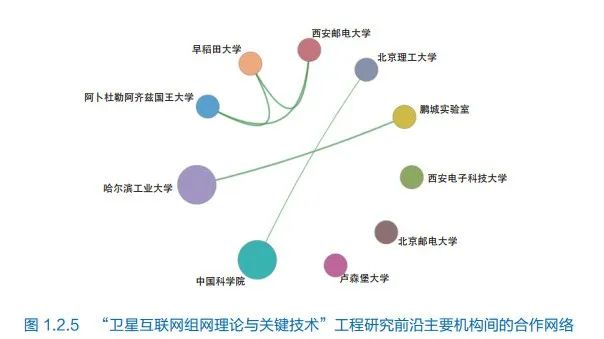
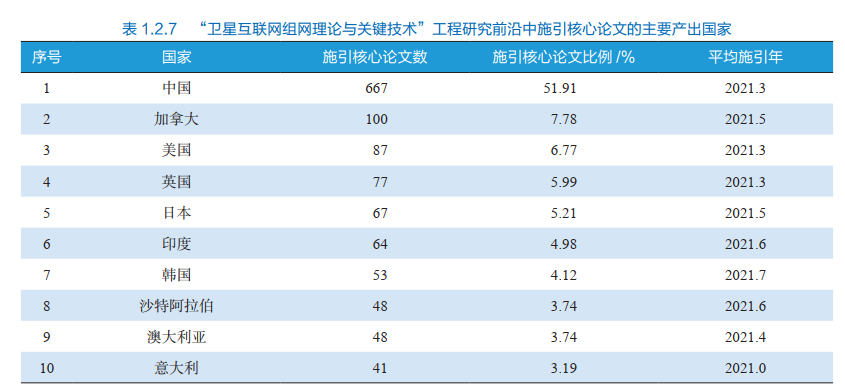
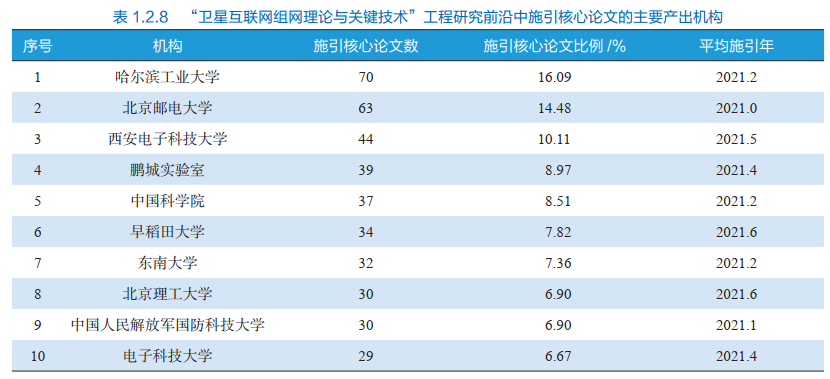
Currently, Satellite Internet has received high attention from major countries and is developing at an unprecedented pace. Figure 1.2.6 illustrates the development route of this frontier. The following continues to outline its development directions in four aspects: network architecture, routing protocols, inter-satellite communication, and mobility management. In terms of network architecture, the NTN network architecture is currently in the discussion and standard-setting stage, expected to be fully formulated and operational by 2027. In terms of routing protocols, the currently adopted fixed routing protocols have inherent flaws that severely restrict network scale and performance, while resilient network protocols are gradually being improved, expected to mature around 2026. In inter-satellite communication, the currently used microwave communication suffers from low rates and strong interference issues, which are gradually being replaced by inter-satellite laser communication, expected to complete the transition around 2026. In mobility management, centralized management faces significant signaling overhead and high transmission delays, thus transitioning towards distributed management. The trends in Satellite Internet development include: firstly, evolving from communication-centric to an integrated development of communication, navigation, and remote sensing, achieving multifunctional capabilities; secondly, transitioning from terrestrial device-assisted access to direct satellite communication with mobile phones, realizing on-demand access; thirdly, evolving from Satellite Internet to Satellite Internet of Things, achieving the vision of interconnectivity. Satellite Internet is currently applied in scenarios such as emergency communication, remote area communication, and logistics communication, and with its rapid development, it is expected to find extensive applications in economic, social, and military fields in the future.
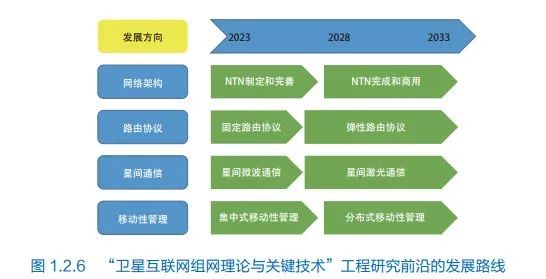

About This Journal
Frontiers of Information Technology & Electronic Engineering (abbreviated as FITEE, Chinese name 《信息与电子工程前沿(英文)》,ISSN 2095-9184, CN 33-1389/TP) is a comprehensive English academic monthly journal in the field of information and electronics, indexed in SCI-E and EI, with a latest impact factor of 3.0, ranked in the JCR Q2 division. It originated from the English version of the Journal of Zhejiang University, C Series: Computer and Electronics, founded in 2010, and was renamed in 2015. It is now a sub-journal of the Academy of Engineering of China in the field of information and electronics, covering fields such as computer science, information and communication, control, electronics, and optics. Article types include research papers, reviews, personal viewpoints, and commentaries. The current editor-in-chief is Academician Pan Yunhe and Fei Aiguo from the Chinese Academy of Engineering. The journal implements an international peer review system, with initial feedback generally provided within 2-3 months. Once accepted, articles will be published online quickly.
In 2019, it was funded by the Excellent Action Plan for Chinese Science and Technology Journals launched by the China Association for Science and Technology and six other ministries (Tiered Journals). From 2021 to 2022, it was selected in the high-quality science and technology journal grading directory in the fields of information and communication (organized by the China Communication Society) and computer science (organized by the China Computer Society), both listed as T1 level; selected in the recommended directory of international academic conferences and journals by the China Computer Society-2022 (cross-disciplinary/comprehensive/emerging).
Official Website: http://www.fitee.zjujournals.com
Journal Springer Homepage: http://www.springer.com/computer/journal/11714
Submission: http://www.editorialmanager.com/zusc
Postal Issuing Code: 32-324
Address: 148 Tianmushan Road, Xihu District, Hangzhou, Zhejiang Province
Phone: +86-571-88273162
Email: [email protected]
|
Computer Science and Technology Group |
Optical Engineering and Technology Group |
|
Control Science and Technology Group |
Information and Communication Group |
|
Electronic Discussion Group |
Artificial Intelligence Group |
